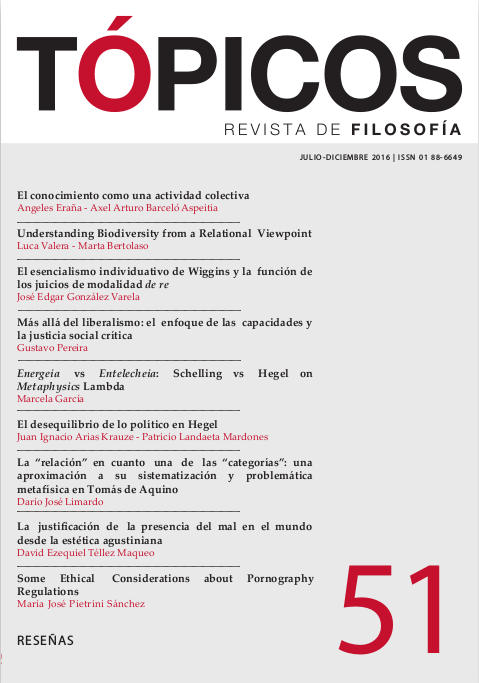Publicado 2016-07-01
Palavras-chave
- biodiversity,
- biological explanations,
- richness,
- en- vironmental and ethical values,
- biological conservation
Como Citar
Resumo
Biodiversity is commonly acknowledged as a universal value in different disciplines. It indicates the heterogeneity of properties that characterizes the biological world. Despite its common use, however, a critical analysis of the philosophical literature shows a difficulty in its conceptualization given an apparent dichotomy between the normative and the descriptive features of the term itself. In this paper we argue that, in order to overcome such tension, the relational aspect of the biodiversity concept should be acknowledged. That is, in order to be a value, any difference in the natural world, which is defined in terms of biodiversity, entails both at a conceptual and explanatory level, the intrinsic relationship between what is in common and what is specific among entities. This makes of biodiversity an explanatory concept in its own right. Through a relational account of biodiversity it is also possible to acknowledge the multi-dimensionality of the notion of biodiversity, which has shown to be really useful in different contexts and better characterized in terms of the “richness” that biodiversity concept entails.
Referências
- Bertolaso, M.; et al. (In press). Robustness as Organized Heterogeneity. Rivista di filosofia Neo-Scolastica, CVIII.
- Bertolaso, M. (2016). A System Approach to Cancer. From Things to Relations. In Philosophy of Systems Biology. S. Green (Ed.) Dordrecht: Springer.
- ____ (2014). Why it has been so difficult to pin down with a definition of nature. Teoria, XXXIV-1, 75-92.
- ____ (2013). Sulla ‘irriducibilità’ della prospettiva sistemica in biologia. In Strutture di mondo. Il pensiero sistemico come specchio di una realtà complessa. Vol. II. L. Urbani Ulivi (Ed.) (143-169). Bologna: Il Mulino.
- Chapman, J. L.; Reiss, M. J. (1999). Ecology: principles and applications. Cambridge: Cambridge University Press.
- Chisholm, R. M. (2005). Intrinsic Value. In Recent Work on Intrinsic Value. T. Rønnow-Rasmussen; M.J. Zimmerman (Eds.) Dordrecht: Springer.
- Hamilton, A. J. (2005). Species diversity or biodiversity? Journal of Environmental Management, LXXV.
- Hewitt, J.; Thrush, S.; Lohrer, A.; Townsend, M. (2010). A latent threat to biodiversity: consequences of small-scale heterogeneity loss. Biodiversity and Conservation, XIX.
- Maclaurin, J.; Sterenly, K. (2008). What is Biodiversity? Chicago and London: The University of Chicago Press.
- Maier, D. S. (2012). What’s So Good About Biodiversity? A Call for Better Reasoning about Nature’s Value. Dordrecht: Springer.
- Marcos, A. (2012). ¿Por qué es buena la biodiversidad? Fundamentos bioéticos del valor de la biodiversidad. Revista Colombiana de Bioética, VII-2.
- Næss, A. (1989). Ecology, Community and Lifestyle. Outline of an Ecosophy. Cambridge: Cambridge University Press.
- O’Neill, J. (2003). The Varieties of Intrinsic Values. In Environmental Ethics. An Anthology. A. Light, H. Rolston III (Eds.) Malden, MA: Blackwell.
- Norton, B. G. (2010). Biodiversity: Its Meaning and Value. In A Companion to the Philosophy of Biology. S. Sarkar, A. Plutyinski (Eds.) Malden, MA: Blackwell.
- ____ (2006). Toward a policy-relevant definition of biodiversity. In The endangered species act at thirty, II. M. Scott, D.D. Goble, F.W. Davis (Eds.) Washington, DC: Island Press.
- ____ (1991). Toward Unity Among Environmentalists. New York: Oxford University Press.
- Rolston III, H. (2003). Value in Nature and the Nature of Value. In Environmental Ethics. An Anthology. A. Light, H. Rolston III (Eds.) Malden, MA: Blackwell.
- ____ (1998). Challenges in Environmental Ethics: Values in and Duties to the Natural World. In Environmental Philosophy: From Animal Rights to Radical Ecology. M.E. Zimmerman, J.B. Callicott, G. Sessions, K.J. Warren, J. Clark (Eds.) Upper Saddle River (NJ): Prentice Hall.
- Santana, C. (2014). Save the planet: eliminating biodiversity. Biology & Philosophy, doi:10.1007/s10539-014-9426-2
- Sarkar, S. (2014). Biodiversity and Systematic Conservation Planning for the Twenty-first Century: A Philosophical Perspective. Conservation Science, II.
- ____ (2010). Diversity: A Philosophical Perspective. Diversity, II (2010).
- ____ (2002). Defining ‘Biodiversity’; Assessing Biodiversity. The Monist, LXXXV-1.
- Sarkar, S.; Margules, C. R. (2002). Operationalizing biodiversity for conservation planning. Journal of Biosciences, XXVII-4.
- UN. (1992). Conference on Environment and Development. Convention on Biological Diversity. Rio de Janeiro: UN.
- Valera, L. (2014). Retorica ed etica ambientale: il contributo di Arne Næss. Medicina e Morale, IV.
- ____ (2013). Ecologia umana. Le sfide etiche del rapporto uomo/ambiente. Roma: Aracne.
- Väliverronen, E. (1998). Biodiversity and the Power of Metaphor in Environmental Discourse. Science Studies, XI-1.
- Vanni Rovighi, S. (2009). Elementi di filosofia. Vol. III. Brescia: La scuola.






